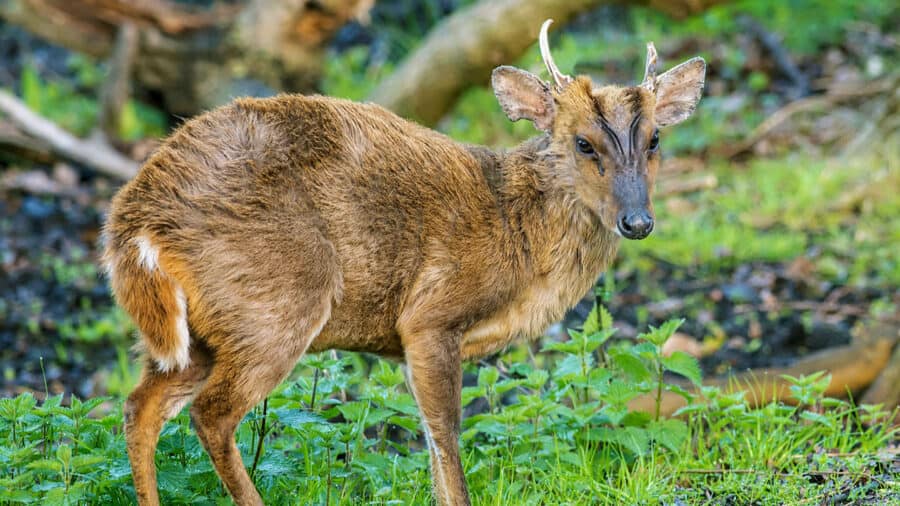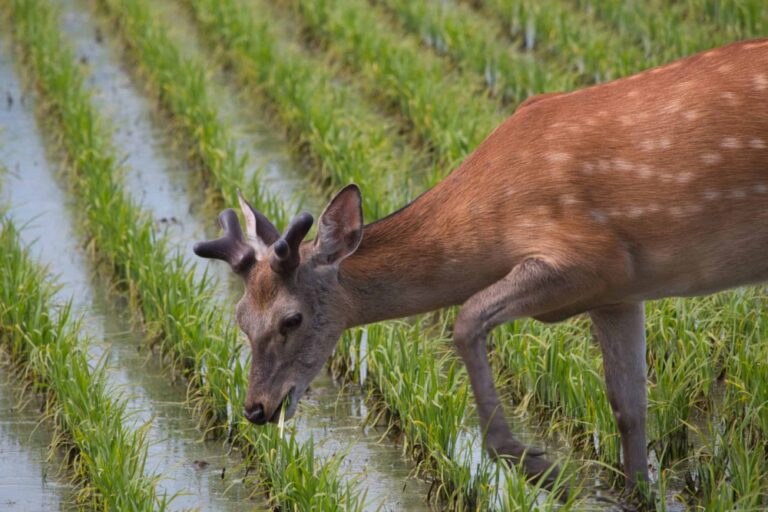In the enchanting realm of wildlife, where majestic creatures roam and captivate our imagination, one cannot overlook the enigmatic presence of the Muntjac deer.

With its diminutive size and elusive nature, this fascinating creature has stirred curiosity among naturalists and wildlife enthusiasts alike. The Muntjac, scientifically known as Muntiacus reevesi, belongs to the family Cervidae, yet it distinguishes itself from its larger relatives in numerous ways.
Muntjac Deer Identification
Measuring around 40 to 50 centimeters in height at the shoulder and weighing between 10 to 18 kilograms, these petite deer present a charming sight. Their distinctively short legs and elongated body form characterize their unique appearance. Moreover, males and females possess small antlers resembling sharp tusks more than conventional branching antlers seen in other deer species.
Original Distribution
Native to South Asia and Southeast Asia, the origin of these delightful creatures can be traced back to regions encompassing India, Sri Lanka, China’s borderlands with Myanmar (formerly Burma), Taiwan, Vietnam, Cambodia, Laos, as well as Indonesia’s Riau Archipelago.
Despite their widespread presence across these regions due to deliberate introductions or accidental releases from captive populations elsewhere for hunting purposes or ornamental reasons, muntjacs have also been introduced in other parts of Europe, including England, where they have successfully established wild populations.
Muntjac Deer Habitat
Muntjacs exhibit impressive adaptability when it comes to selecting their habitats. These resourceful creatures can thrive in diverse environments ranging from dense forests with thick undergrowth to scrubland areas or even disturbed habitats like plantations or suburban gardens adjacent to wooded areas.
Their ability to utilize various habitats has significantly influenced their successful colonization outside their native range.
Muntjac Deer Behavior
While muntjacs are generally solitary animals that prefer their own company, they can occasionally be seen forming small groups consisting of a female and her offspring. These secretive creatures are most active during dawn and dusk, using their well-developed senses to navigate their habitat.
Muntjacs rely on acute hearing and an excellent sense of smell to avoid predators such as tigers, leopards, or dholes. The captivating allure of the Muntjac deer lies not only in its distinct appearance but also in its intriguing ecology.
As we delve deeper into the various aspects of this creature’s life, we will unravel the mysteries surrounding its origin, behavior, habitat preferences, and unique features that set it apart from other deer species. Join us on this journey as we explore the captivating world of the Muntjac deer.
The Origin Story: Where Did Muntjacs Come From?
Muntjac deer, scientifically known as Muntiacus, has a fascinating origin story that traces back to the ancient forests of Southeast Asia and the Indian subcontinent. These diminutive yet captivating creatures belong to the family Cervidae, which includes deer species worldwide.
With a history that spans millions of years, muntjacs have evolved into several distinct subspecies. Muntiacus comprises 12 recognized species, each displaying unique characteristics and habitat adaptations.
The most widely known is the Indian Muntjac (Muntiacus muntjak), sometimes called the barking deer due to its distinctive vocalizations. Muntjacs are believed to have originated in Southeast Asia and gradually spread across various regions.
Fossil records indicate their presence in China dates back over seven million years, while remains discovered in India suggest an ancient lineage of approximately five million years. These findings provide insights into their evolutionary journey and dispersal patterns.
The diverse range of muntjac species reflects their ability to adapt to different ecological niches. Despite being small compared to other members of the deer family, they display remarkable survival skills that have allowed them to thrive in various habitats.
From dense tropical rainforests and subtropical woodlands to open grasslands and montane regions, muntjacs have successfully colonized diverse landscapes. Understanding the breeding behavior of muntjacs provides further insight into their origin story.
These deer are known for their solitary nature but engage in brief courtship rituals during mating season. Females give birth mainly during spring or early summer after a gestation period of approximately seven months.
The newborn fawns are precocial – born fully developed and capable of moving independently just hours after birth. It is important not to confuse muntjacs with other deer species, especially due to their small size and unique characteristics.
Distinct Features: What Sets Muntjac Deer Apart
With their petite yet robust frame, Muntjac deer possess distinctive features that differentiate them from their larger cervid counterparts. These fascinating creatures have evolved several physical attributes contributing to their adaptability and survival in diverse habitats.
As we delve into the unique characteristics of muntjacs, we uncover a world of remarkable qualities. One of the most striking features that sets muntjac deer apart is their diminutive size.
Standing at an average height of 40-50 centimeters (15-20 inches) at the shoulder, they are among the smallest deer species globally. This compact stature allows them to navigate through thick vegetation and refuge in dense forests where larger herbivores would struggle.
Despite their small size, muntjacs possess muscular bodies and sturdy legs that enable swift movements when escaping predators or exploring their territories. To aid in camouflage and concealment within their surroundings, muntjac deer exhibit a beautiful coat patterned with a mix of reddish-brown hues.
This cryptic coloration helps them blend seamlessly with the dappled light filtering through forest foliage or tall grasses. Additionally, muntjacs sport short fur, which further aids in maneuvering through dense vegetation without getting entangled or weighed down.
Another distinct feature these elusive creatures possess is the presence of fang-like canine teeth known as tusks or “tushes.” These elongated upper canines are found in both males and females but are more prominent in males and play a role during territorial disputes or rutting season displays. The tushes are weapons to ward off rivals and assert dominance over breeding territories.
Furthermore, muntjac deer have notably large ears relative to their body size. Their oversized auditory organs serve multiple purposes – enhancing sound reception for early warning signals from potential threats while also assisting in thermoregulation by dissipating excess heat.
These conspicuous ears, combined with their well-developed sense of hearing, allow muntjacs to detect the slightest rustle in the undergrowth or distant sounds that may indicate danger. Muntjac deer possess distinct features that distinguish them from other deer species.
Their small stature, cryptic coat patterns, fang-like tushes, and large ears contribute to their survival in various habitats and aid in their interactions within social structures. While these unique characteristics make them captivating to observe and study, they also shed light on the remarkable adaptability of these enigmatic creatures in the natural world.
A Muntjac’s World: Understanding Their Habitat
Ecology
To fully comprehend the world of the elusive Muntjac deer, one must delve into the intricacies of its habitat. These remarkable creatures have adapted to diverse ecosystems, displaying an impressive ability to thrive in various climates and terrains. From dense woodlands to open grasslands, Muntjacs have successfully adapted their behavior and physical attributes to survive in these habitats.
Habitat
Muntjacs are most commonly found inhabiting thick forests and woodlands, where their small size and agile nature allow them to navigate through dense vegetation easily. The undergrowth provides them shelter and ample food sources, making these areas ideal for survival. However, they are not limited solely to wooded areas; they have also been known to occupy scrublands and even agricultural landscapes in some regions.
Field Signs
When exploring a Muntjac’s habitat, one can often spot various field signs that indicate their presence. Keep an eye out for trampled vegetation along well-trodden pathways as evidence of their frequent movements. Additionally, browsing marks on low-lying shrubs and saplings may be visible, showcasing their feeding habits. Their territorial behavior is marked by scent-marking with preorbital glands on trees or bushes within their range — a distinct sign indicating the boundaries of their habitat.
Description
The favored habitats of Muntjacs are typically characterized by dense vegetation cover that provides essential resources such as food and shelter.
They show a preference for areas where vegetation density is high enough to provide concealment from predators but still allow for easy movement through the undergrowth. This enables them to browse on leaves, bark, fruits, and various plant parts while remaining hidden from potential threats.
Confusion species
It is worth noting that certain regions may have confused species or other deer species coexisting in similar habitats as the Muntjac. For example, in some Southeast Asia, they may share their habitat with barking deer, sambar deer, or even the larger Indian Muntjac. Understanding the subtle differences in behavior and physical characteristics is crucial for accurate identification.
The Muntjac’s habitat shapes its behavior, diet, and overall survival. Their ability to adapt to various ecosystems demonstrates their ecological flexibility. Whether it be dense woodlands or open grasslands, these remarkable creatures have established themselves as survivors in diverse habitats across their distribution range. By understanding their preferred habitats and recognizing field signs of their presence, we gain valuable insights into the captivating world of Muntjac deer.
Behavior and Social Structure
Muntjac deer, known for their small size but big personalities, exhibit intriguing behavior and possess complex social structures. Despite their diminutive stature, these fascinating creatures display a range of captivating and unique behaviors. One notable aspect of the Muntjac’s behavior is their solitaMuntjac’s.
Unlike many deer species that form herds or live in family groups, the Muntjac prefers a more independent Muntjacyle. Generally, they are territorial animals, establishing and defending their small territories, encompassing areas rich in food sources and suitable shelter.
These territories are marked by scent glands located on the Muntjac’s face and between its hooMuntjac’sin these territories, muntjacs exhibit territorial behavior by vocalizing with a series of short barks or loud shrieks, alerting intruders to stay away.
This vocalization is particularly prominent during breeding when males compete for females. The winner establishes dominance through vocalizations and sparring with other males using their sharp antlers.
Despite being solitary creatures for most of the year, muntjacs occasionally form loose associations with others during certain times. For example, during winter, when food becomes scarce, or during mating season, when males search for receptive females, they may temporarily tolerate the presence of other individuals within their territory.
The social dynamics within muntjac populations can be complex due to overlapping territories and occasional encounters between individuals. These interactions can lead to brief confrontations or chases as each deer defends its personal space.
However, these territorial disputes rarely escalate to physical altercations since most conflicts can be resolved through vocal displays and scent marking. While muntjacs typically lead solitary lives within individual territories throughout most of the year, they exhibit some level of social interaction during specific periods, such as mating season or when resources are scarce.
Their ability to communicate through varied vocalizations and scent marking, coupled with their territorial behavior, contributes to the intricate social structure of these captivating creatures. Understanding their behavior provides valuable insight into the fascinating world of muntjac deer.
The Muntjac and Human Interaction
In the realm of wildlife, few encounters are as enchanting as those between humans and the captivating Muntjac deer. Native to South Asia, these elusive creatures have made a remarkable impression on local communities and nature enthusiasts. The complex relationship between humans and Muntjacs is a tapestry woven with threads of admiration, curiosity, and, sometimes, conflict.
Diet plays a significant role in shaping the interactions between Muntjac deer and humans. These omnivorous creatures possess a versatile palate, devouring everything from grasses and leaves to fruits and even small animals like birds or rodents.
Unfortunately, this flexibility can lead to instances where Muntjacs venture into human settlements for sustenance. Gardens filled with succulent vegetables become a delectable temptation for these graceful foragers.
Originating from the dense forests of South Asia, Muntjacs have spread their presence across various regions over time. Their introduction into new habitats has occasionally fostered conflicts with local farmers due to their tendency to nibble on crops such as rice or maize.
This has led some communities to view them as pests threatening their livelihoods. However, it is essential to approach this issue with nuance since it often arises from the encroachment of human activities on the natural habitats of Muntjacs.
Conservation efforts are integral to ensuring harmonious coexistence between humans and Muntjac deer populations. Diligent monitoring of their numbers helps maintain healthy ecosystems while addressing potential conflicts preemptively.
Moreover, educational initiatives promoting awareness about these fascinating creatures can foster empathy among communities close to their habitats. Despite occasional frictions arising from crop damage or habitat encroachment concerns, many individuals cherish encounters with the endearing Muntjac deer species.
Their gentle appearance and graceful movements evoke admiration among nature enthusiasts worldwide. We must appreciate the delicate balance required when interacting with these captivating creatures as they contribute to the intricate web of life that sustains our natural world.
Where and How to Spot a Muntjac Deer
When spotting the elusive Muntjac deer, there are a few key factors to remember. These enchanting creatures can be found dwelling in various regions, making it imperative for nature enthusiasts to strategize their search accordingly.
Understanding their preferred habitats and behavior is crucial before embarking on your quest to catch a glimpse of these captivating mammals. Muntjac deer are native to South Asia but have been introduced in several countries worldwide due to their adaptability.
In Europe, they thrive in the dense woodlands of England, where they have established stable populations. The best time for spotting them is during the early morning or late evening when they are most active.
Locating muntjacs can become quite challenging with their small size and ability to remain hidden amongst thick foliage. These deer prefer habitats with ample cover, such as woodland edges and thick undergrowth near water sources.
Their fondness for dense vegetation allows them to blend seamlessly into their surroundings, making it difficult for even the keenest observer to spot them from afar. To increase your chances of encountering a muntjac, focus your search efforts near woodland boundaries or areas with abundant shrubs and low-hanging vegetation.
Identifying signs that indicate Muntjac’s presence can also aid in successfully spotting them. Look for characteristic field signs, such as fresh tracks left behind by these dainty-hooved animals while crossing paths or feeding.
Watch for chewed vegetation at lower heights – a telltale sign that muntjacs have been actively browsing nearby. Conservation organizations recommend maintaining a respectful distance when observing wildlife; this also holds when attempting to spot muntjac deer.
Patience becomes paramount as you silently wait for any movement or sound indicating their presence amidst the serenity of nature’s symphony. Spotting a muntjac deer is a thrilling endeavor that requires patience, knowledge of their preferred habitats, and keen observation skills.
Whether you wander through the woodlands of England or explore their native lands in South Asia, knowing where and how to spot these elusive creatures will heighten your chances of encountering them in the wild. Remember to respect their space and the natural environment as you embark on this enchanting quest to witness the beauty of muntjac deer firsthand.
FAQs: What Everyone Asks About Muntjac Deer
Are Muntjac deer native to North America?
Muntjac deer, scientifically known as Muntiacus, are not native to North America. They originate from Southeast Asian forests, specifically in countries such as China, Taiwan, India, Sri Lanka, and Indonesia. However, due to human intervention and the establishment of non-native populations for hunting purposes or accidental escapes from captivity, small populations of muntjacs can now be found in certain regions of the United States and Europe. These introduced populations have adapted to their new environments but are considered invasive species.
What is the size and description of a typical muntjac deer?
Muntjac deer exhibit sexual dimorphism in size and appearance. Adult males (bucks) typically measure between 44 and 53 inches (110-135 cm) in length and stand around 22 inches (55 cm) at the shoulder. They weigh between 33-44 pounds (15-20 kg).
Females (does), on the other hand, are slightly smaller, with an average length of 39-47 inches (100-120 cm), and weigh around 26-33 pounds (12-15 kg). Muntjacs have short legs that allow them to navigate through dense vegetation easily.
Their physical appearance varies depending on the species within the Muntiacus genus; however, they generally possess a reddish-brown coat with lighter undersides. One distinctive feature is their prominent facial markings: males possess small antlers covered in velvet-like fur, while females don’t have antlers but may display tiny bony knobs.
What do muntjacs eat?
Muntjacs are herbivores with a varied diet consisting mainly of leaves, shoots, fruit, seeds, grasses, and bark, depending on seasonal availability. They are opportunistic feeders, meaning they adapt their diet to the resources in their habitat. This flexibility allows them to survive in different environments and ensures they can find food year-round.
What is the conservation status of muntjac deer?
The conservation status of muntjac deer varies among species due to differences in population sizes and ranges. Some species, such as the Indian Muntjac (Muntiacus muntjak), are muntjacs least concern by the International Union for Conservation of Nature (IUCN) due to their large populations and broad distribution across Asia. However, other species, like the Bornean yellow Muntjac (Muntiacus atherodes), are vulnerable to habitat loss caused by deforestation.
Ongoing research and conservation efforts focus on understanding these elusive creatures better and preserving their habitats. We must continue monitoring and protecting these unique animals to ensure their long-term survival in the face of human activities and environmental changes.

Conclusion: Why the Muntjac Captures Our Imagination
In the depths of our imagination, some creatures captivate us with their charisma and charm. The Muntjac deer is undoubtedly one such exquisite creature that has woven its way into our collective fascination. With its enchanting presence and intriguing traits, it is no wonder that the Muntjac deer continues to hold a special place in our hearts.
Additional Resources
For those intrigued by the enigmatic world of Muntjac deer, many resources are available to delve deeper into their fascinating nature. Below are some recommended sources for further exploration and understanding.
- Field Guides: Field guides are invaluable companions for nature enthusiasts and wildlife observers. One highly acclaimed resource is “Mammals of Europe, North Africa, and the Middle East” by S. Aulagnier et al. This comprehensive field guide provides detailed information on various species, including Muntjac deer, covering their identification, distribution, habitat preferences, and more. Its stunning illustrations make it an excellent tool for identifying these captivating creatures in the wild.
- Scientific Journals: For scientifically inclined individuals seeking in-depth research and scholarly articles on Muntjac deer, perusing scientific journals can be immensely rewarding. Journals like “Mammal Review” or “Journal of Wildlife Management” often publish studies exploring different aspects of Muntjac biology and ecology, such as breeding behavior, conservation status assessments, or population dynamics. These journals provide a wealth of information from experts in the field.
- Wildlife Conservation Organizations: Dedicated to preserving biodiversity and safeguarding precious wildlife species worldwide, several conservation organizations actively work towards protecting Muntjac deer populations from threats such as habitat loss or hunting pressure. The International Union for Conservation of Nature (IUCN) is a prominent organization that publishes assessment reports on endangered species’ conservation status worldwide; its website contains valuable information regarding Muntjacs’ current status and efforts to ensure their long-term survival.
- Online Forums and Citizen Science Projects: Joining online forums or participating in citizen science projects can offer unique opportunities to connect with fellow enthusiasts while contributing to ongoing research efforts focused on Muntjac deer. Platforms like iNaturalist or eBird allow individuals to share sightings, photographs, recordings, or behavioral observations of wildlife they encounter in the field.
Engaging in such platforms not only broadens one’s knowledge but also aids in accumulating data that can further enhance our understanding of these captivating creatures. A plethora of resources await those who wish to delve deeper into the captivating world of Muntjac deer.






